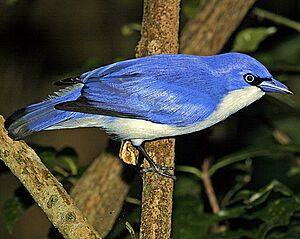Madagascar blue vanga facts for kids
Quick facts for kids Madagascar blue vanga |
|
|---|---|
 |
|
| Conservation status | |
| Scientific classification | |
| Synonyms | |
|
The Madagascar blue vanga (Cyanolanius madagascarinus) is a beautiful blue bird that lives only on the island of Madagascar. It belongs to the Vangidae bird family. You can find it in warm, wet forests and dry forests across the island.
Contents
How the Blue Vanga Got Its Name
In 1766, a Swedish scientist named Carl Linnaeus gave the Madagascar blue vanga its first scientific name, Loxia madagascarina. He included it in his famous book, Systema Naturae. Later, in 1854, another scientist, Charles Lucien Bonaparte, placed this bird in a new group called Cyanolanius. This is how it got its current scientific name, Cyanolanius madagascarinus.
What the Blue Vanga Looks Like
The Madagascar blue vanga is a small bird, about 16 to 19 centimeters (6 to 7.5 inches) long. It weighs around 19.5 to 25.5 grams (0.7 to 0.9 ounces).
Adult male blue vangas are very bright blue. They have a black line that goes through their eye and around their bill. Their tail, wing edges, and wing tips are black. Their throat and belly are bright white.
Female blue vangas are a bit less bright than males. Their belly is off-white with a light orange or buffy color. Their wings might look a little greenish.
Young blue vangas have a grayish-blue head. The rest of their upper body is dark greenish-olive. Their tail looks like a female's but is duller. Their throat is dirty-white, and their belly is olive-buff.
The beak of an adult male is a vivid pale blue with a dark tip. Females have a dark brown beak. Young birds have a black beak with a pale pink base. Males have sky-blue or greenish-blue eyes, while females and young birds have brown eyes. Males have black legs, and females have gray legs.
Blue Vanga Calls and Songs
These birds make a special sound that is like tcccch. Sometimes they repeat it to make a longer sound, like chrr-crrk-crrk-crrrrk-crk-crk. This sounds a bit like the Chabert vanga. Their song can be fast or slow. They also make a teea teea teea sound or a harsh scheet, which might be an alarm call to warn others of danger.
Blue Vanga Habits and Life
What They Eat
Madagascar blue vangas mainly eat insects. This includes beetles, crickets, cicadas, and caterpillars. They also enjoy eating spiders. Sometimes, they will eat berries. Birds on Mohéli island have even been seen eating fruit.
They look for food in the middle and upper parts of trees. They often hang upside down to find food. Most of their food is picked directly from branches and leaves. They also fly out to catch insects from branches and leaves. They usually hunt in groups of up to six birds when it's not breeding season. During nesting, they hunt in pairs. They are also seen hunting with other types of birds.
Reproduction and Nests
The breeding season for blue vangas is usually from October to December. Both the male and female bird help take care of their young. Nests are often built about 12 meters (39 feet) high in trees. They are placed where slender branches meet.
The nest is shaped like a cup. It is made from thin twigs and soft, down-like material. The eggs are pale blue to green. They have small lilac-gray to red-brown spots, which are thicker at the wider end of the egg. The eggs are about 19.9–21.2 mm long and 15.8–16.2 mm wide.
Where the Blue Vanga Lives
The Madagascar blue vanga lives in the northern, eastern, and western parts of Madagascar. In the west, they live in dry forests where trees lose their leaves. In the east, they live in humid forests where trees stay green all year. They can also be found in coastal forests, nearby new forests, and even in mangroves. They usually live at elevations up to 1,200 meters (3,900 feet), but some have been seen as high as 1,600 meters (5,200 feet).
Conservation Status
The Madagascar blue vanga is doing well. It has a large population and lives in many places. Because of this, the IUCN Red List says it is a species of "least concern." This means it is not currently at risk of disappearing.



